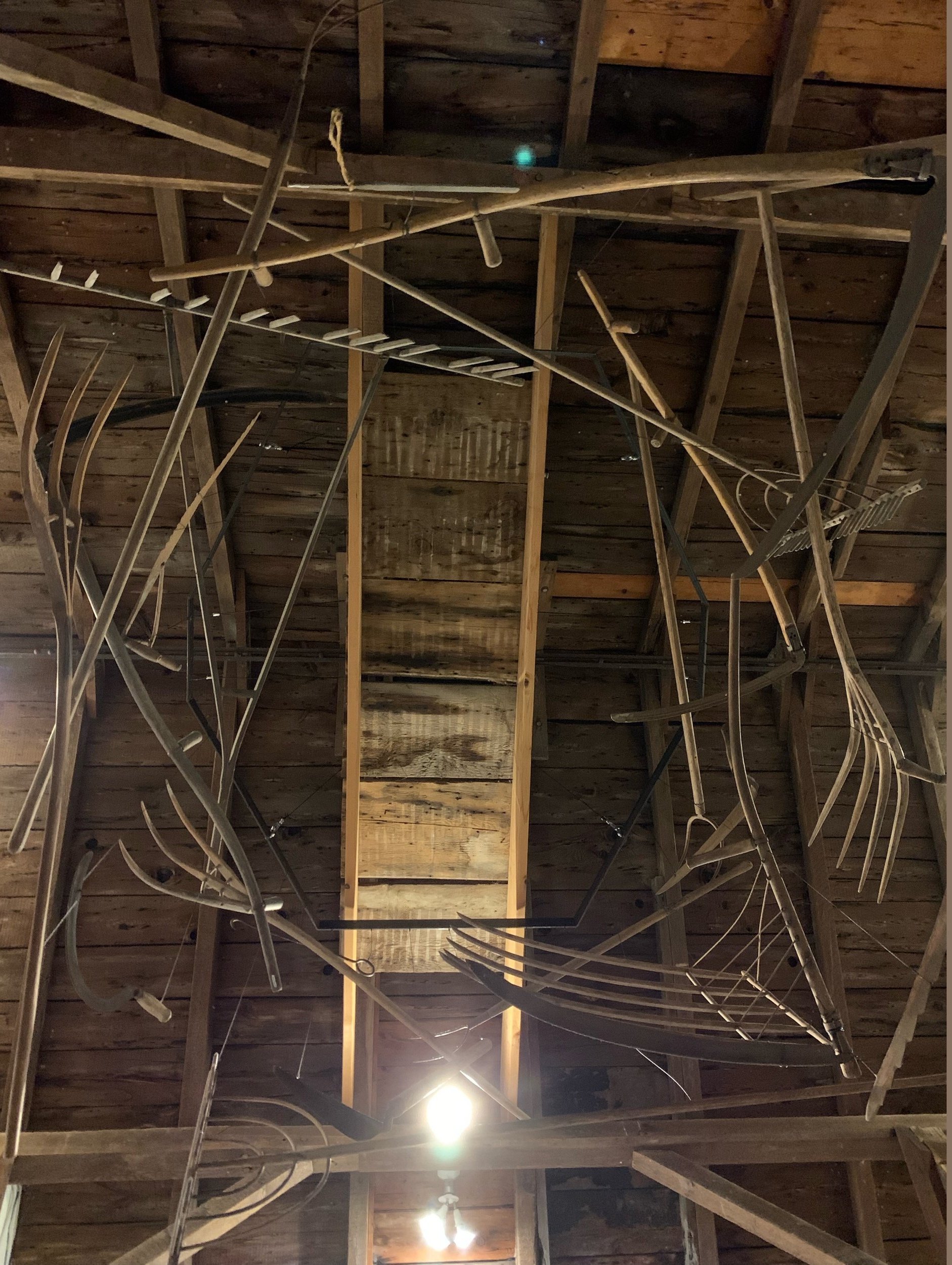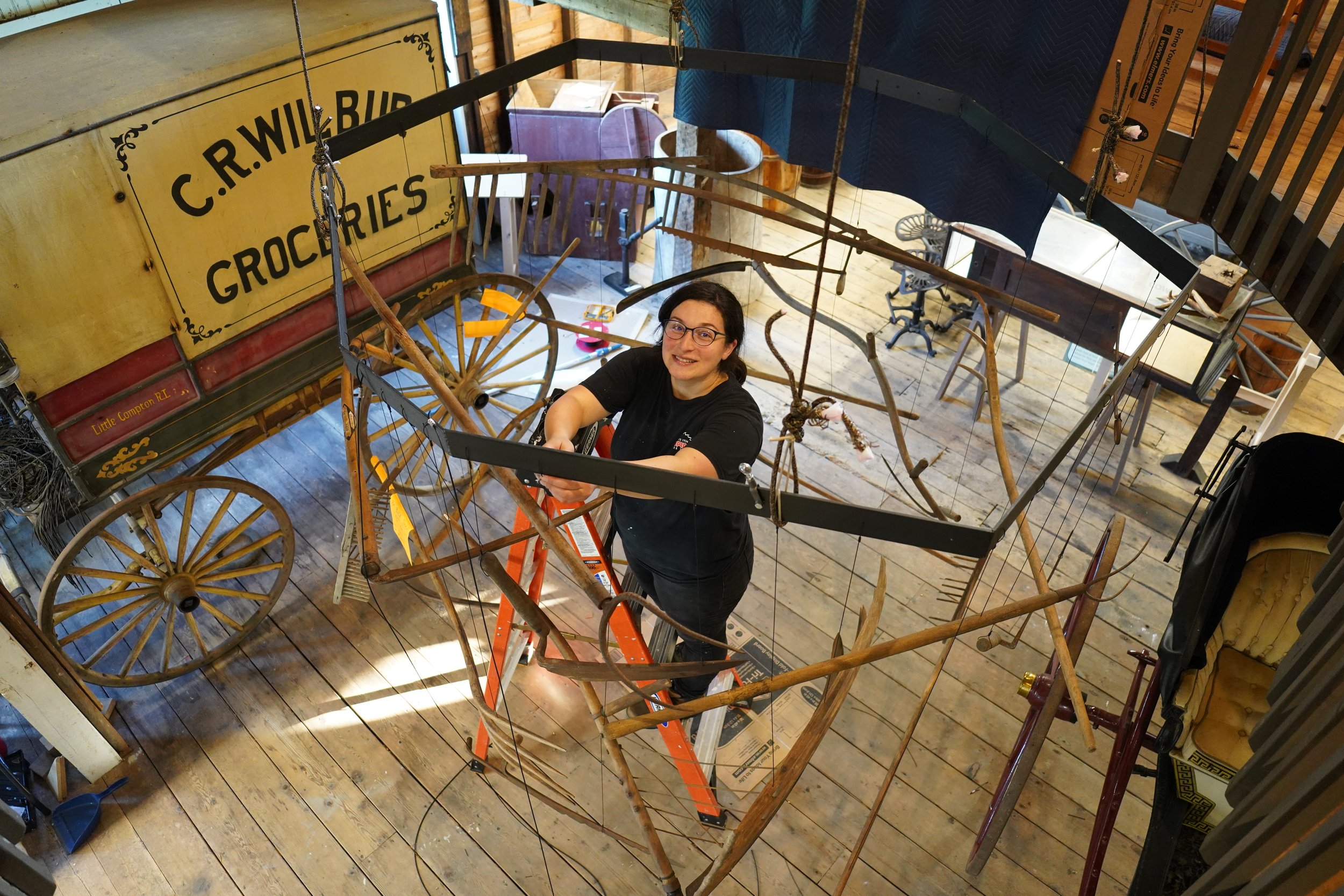Haymakers Helix
Photo by Karen Philippi
Photo by Karen Philippi
Haymaker’s Helix was commissioned by the Little Compton Historical Society for their permanent exhibition “Everyone was a Farmer.” It was installed June 2021 and is available for public view during exhibition hours. The sculpture is a mobile created out of historic haymaking tools installed permanently in the 19th century barn.
Exhibition open: 10 AM to 5 PM Tuesday – Sunday – Everyone Was a Farmer & Women’s History Project. Private Tours, Research, and Educational Programs Year-Round by Appointment – Fees may apply.
548 West Main Road, Little Compton, RI 02837, 401-635-4035
(please check LCHS website to confirm open hours as they may change)
A note about this work:
As I have lived with this piece, my relationship to it has shifted. Although the process of hay-making is honest and humble work, in the town of Little Compton, (and many towns in the US) the establishment of hayfields and pastured farms was an aspect of the colonial project to remove and erase the original inhabitants. Many colonial farms (including in Little Compton) were established and operated with the exploitation of enslaved people’s labor and indentured work. In the case of Little Compton, the colonial farms displaced the Sakonnet people, along with their regenerative indigenous agricultural practices and responsible land stewardship. If this piece celebrates 20th century hay-making without those acknowledgments, it runs the risk of becoming an extension of that colonizing work. The ways that we tell and understand our histories shapes our communities identities, and the ways we build our future. If I’d been thinking more critically about this at the time of this sculpture's design, I might have made it differently. I hope that this reflection will help others to recognize, when admiring the wind rippling through a hayfield, or bales resting on a meadow, that underneath the peaceful appearance of that scene the soil remembers the violence of the attempts by Little Compton’s colonial ancestors to exile, enslave, exterminate and erase our town’s original inhabitants, and their exploitation of enslaved workers. Our indigenous community members and the descendants of those enslaved remember. Its the responsibility of each person in our town to learn remember and acknowledge this. I am working to educate myself and to behave accordingly.
I am in conversation with the Little Compton Historical Society to re-make the accompanying sign with this piece to make a permanent acknowledgement of this historical context. The surrounding exhibition does acknowledge the pre-colonial indigenous agricultural practices and the violence of colonization and the history of American slavery in our community, however I believe that more can be done within and beyond the exhibition. The LCHS have been very receptive and supportive of this conversation. They have done a research project on the history of slavery in Little Compton and are currently in the process of embarking on a longer term larger research project into the local indigenous history of the town. I am told that the project will include paying indigenous scholars for research.
Half of my artist fee for this sculpture has been split and given to the Tomaquag Museum, The Wôpanâak Language Reclamation Project, The Northeast Farmers of Color Land Trust (NEFOC LT), and The Pocasset Pokanoket Land Trust. I will continue to support these organizations and other local efforts to tell truthful histories and support contemporary indigenous projects.
original artist statement:
Haymaking is a slow and steady process, each swing of the scythe in rhythm with the haymaker's breath and gait, each step in time with the seasons. Seeds sown in the fall wait for the days to lengthen and the soil to drink up spring rains. As tender stalks sprout, stiffen, leaf and seed, the haymaker observes, and mows at just the right time, slicing the stalks and letting them fall to dry in the sunshine, tedding, raking, baling, and stacking.
Haymaking is an act of care and preservation. While the livestock munch fresh green pastures, the farmer is busy saving the fruits of the sunshine for the cold cozy winter months in the barn. Seasons pass, haystacks amass and deplete. The cycle repeats, time advances, new lessons learned. Seasons become years, years become generations, generations become history. This sculpture commemorates time’s spiral from the haymaker's perspective, one step, swing, rake, pitch, bale, and stack at a time.
Process + Install shots:





